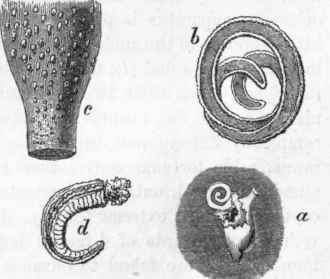Helminthozoa. Part 15
Description
This section is from the book "General Outline Of The Organization Of The Animal Kingdom, And Manual Of Comparative Anatomy", by Thomas Rymer Jones. Also available from Amazon: A General Outline of the Animal Kingdom and Manual of Comparative Anatomy.
Helminthozoa. Part 15
The sperm is usually accumulated in the bottom of the uterus to such an extent as to render it probable that this is the locality where the fecundation of the ova takes place*.
(428). The male Ascaris lumbricoides is considerably smaller than the female, and the structure of its generative system remarkably similar to what has been just described in the other sex. The testis or gland, which secretes the impregnating fluid, is a single, delicate, tubular filament (fig. 78,2, f), which, when unravelled, is found to be nearly 3 feet in length, and is seen winding, in close and almost inextricable folds, around the middle and hinder parts of the intestine. The termination of this tube, g, may be traced to the tail or anal extremity of the worm, where it ends in a filamentary retractile penis, i, in which the microscope exhibits a minute receptacle, wherein the seminal fluid accumulates preparatory to its expulsion. During copulation the penis of the male is introduced into the vulva of the female, by which it is firmly embraced, and the different positions which the external parts occupy in the two sexes is evidently an arrangement favourable to their intercourse.

Fig. 79. Trichina spiralis.
* Siebold, loc. cit.
(429). The Trichina spiralis (fig. 79) is an Entozoon found in immense numbers imbedded in the cellular intervals between the muscular fibres; and in some instances all the voluntary muscles seem full of these creatures, exhibiting, when viewed with the naked eye, an appearance imitated in the annexed figure (fig. 79, c.) On examining the white specks attentively under the microscope, every one of them is seen to be a flask-shaped vesicle, apparently formed of condensed cellular membrane, in which the minute animal is lodged; and when this outer covering is ruptured, as at a, the worm escapes. A magnified view of the Entozoon is given at b, coiled up in the position in which it is seen prior to the destruction of the sac that enclosed it. The body seems to be filled with granular matter, which escapes when the worm is torn asunder (d); but whether it possesses a true alimentary tube is not as yet satisfactorily determined.
Continue to:


